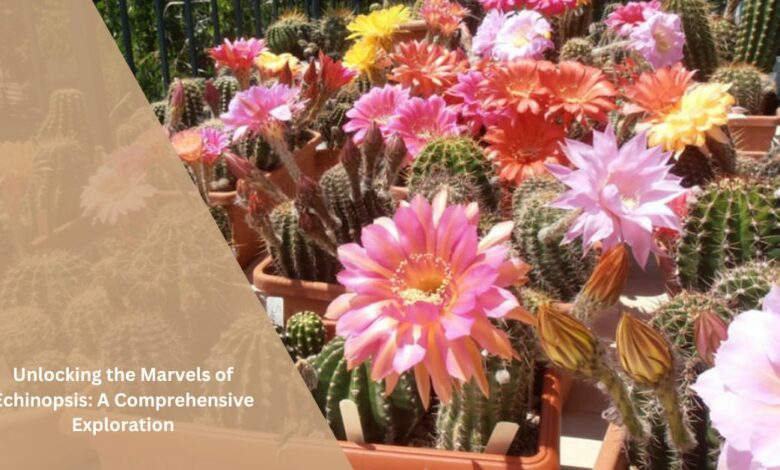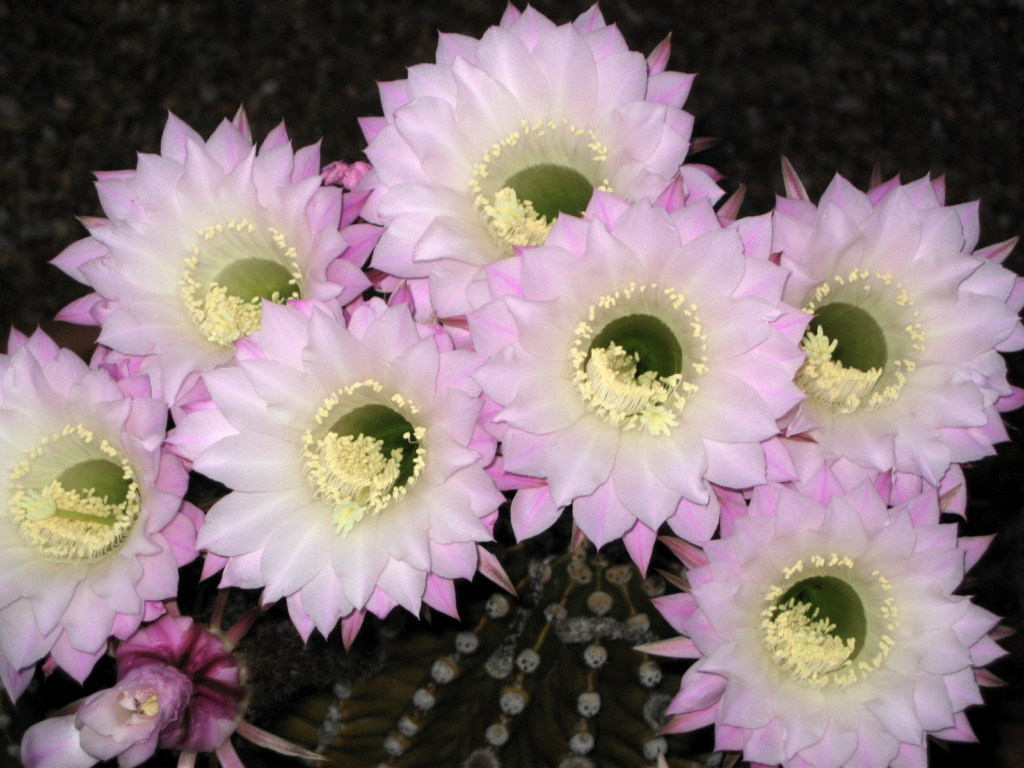Unlocking the Marvels of Echinopsis: A Comprehensive Exploration

Echinopsis, a genus of cacti renowned for its spectacular flowers and intriguing morphology, captivates enthusiasts and botanists alike.
With over 100 recognized species, Echinopsis boasts a diverse array of forms, colors, and adaptations, making it a fascinating subject for study and admiration.
Understanding Echinopsis: Origins and Diversity
Echinopsis originates from the arid regions of South America, primarily in Argentina, Bolivia, Chile, Peru, and Brazil. This vast geographic range has facilitated the evolution of various species, each uniquely adapted to its specific habitat.
From the towering Echinopsis terscheckii to the diminutive Echinopsis chamaecereus, the genus showcases an impressive spectrum of sizes and shapes.
The Splendor of Echinopsis Flowers:
One of the most captivating features of Echinopsis is its flowers. These blooms, often large and vividly colored, emerge in abundance during the plant’s blooming season, typically in spring or summer.

The flowers range from pure white to vibrant shades of pink, red, orange, and yellow, attracting pollinators such as bees, butterflies, and hummingbirds. Echinopsis flowers, with their ephemeral beauty, serve as a testament to nature’s creativity and resilience.
Echinopsis in Cultivation: Tips for Success
Echinopsis has gained popularity among horticulturists and succulent enthusiasts for its relative ease of cultivation and striking ornamental value.
When cultivating Echinopsis, it is essential to provide well-draining soil, ample sunlight, and occasional watering, mimicking its native habitat conditions.
Propagation is commonly achieved through seeds or offsets, allowing enthusiasts to expand their collection and share these marvels with others.
Exploring Echinopsis Hybrids and Varieties:
In recent years, hybridization has played a significant role in expanding the diversity of Echinopsis cultivars available to enthusiasts.
By crossing different species, hybridizers have created hybrids with unique characteristics, such as larger flowers, diverse color patterns, and compact growth habits.
Whether it’s the breathtaking Echinopsis ‘Flying Saucer’ or the whimsical Echinopsis ‘Rainbow Burst,’ hybrid varieties add another layer of fascination to the genus.
Echinopsis in Art and Culture:
Beyond its botanical significance, Echinopsis has also made its mark in art and culture. Artists and artisans draw inspiration from its striking appearance, incorporating its likeness into paintings, sculptures, and decorative motifs.
In indigenous cultures of South America, Echinopsis holds symbolic importance, representing resilience, endurance, and adaptability in the face of adversity.
Conservation Efforts and Challenges:
Despite its resilience, many species of Echinopsis face threats from habitat loss, climate change, and illegal collection. Conservation efforts are underway to protect these iconic plants and their native ecosystems.
Botanical gardens, research institutions, and conservation organizations collaborate to study, propagate, and reintroduce endangered Echinopsis species into their natural habitats, ensuring their survival for future generations to appreciate.
The Intricacies of Echinopsis Physiology:
Beyond its aesthetic appeal, Echinopsis exhibits fascinating physiological adaptations that enable it to thrive in arid environments. One notable adaptation is its ability to store water in specialized tissues, such as its thickened stems, allowing it to endure prolonged periods of drought.
Additionally, Echinopsis possesses shallow but extensive root systems, which efficiently absorb water from the soil after rainfall.
These adaptations highlight the plant’s remarkable ability to survive in harsh conditions and underscore its importance as a model organism for studying desert ecology and plant physiology.
Echinopsis in Traditional Medicine and Folklore
Throughout history, various indigenous cultures in South America have utilized Echinopsis and other cacti for medicinal purposes. Extracts from certain Echinopsis species have been traditionally used to treat ailments such as inflammation, digestive disorders, and skin conditions.
Additionally, these plants hold cultural significance in rituals and ceremonies, symbolizing spiritual connections with nature and ancestral wisdom.
While modern medicine has surpassed traditional remedies in many aspects, the cultural significance of Echinopsis in indigenous communities persists, highlighting the deep-rooted relationship between humans and plants.
Echinopsis as a Source of Genetic Diversity
In addition to its ornamental value, Echinopsis serves as a valuable genetic resource for plant breeders and researchers. The genus harbors a wealth of genetic diversity, making it an attractive candidate for studying evolutionary processes and developing new varieties with desirable traits.
By exploring the genetic makeup of different Echinopsis species, scientists can uncover valuable insights into adaptation, speciation, and biodiversity conservation.
Furthermore, the genetic diversity within Echinopsis offers potential avenues for breeding crops with enhanced resilience to environmental stresses, contributing to global food security efforts.
Echinopsis in Literature and Popular Culture
Echinopsis has left its mark on literature, art, and popular culture, inspiring writers, poets, and artists with its otherworldly beauty and symbolism. From poetry celebrating the resilience of desert flora to paintings capturing the vibrant hues of Echinopsis flowers, the genus has found its way into various artistic expressions.

Moreover, Echinopsis occasionally makes appearances in literature and film, serving as a metaphor for endurance, transformation, and the cyclical nature of life. Its presence in cultural works further underscores its significance as a symbol of natural wonder and human creativity.
Echinopsis: An Ecosystem Engineer
Beyond its individual characteristics, Echinopsis plays a vital role as an ecosystem engineer within its native habitats. In arid regions where water is scarce, these cacti provide critical resources and shelter for a diverse array of organisms.
Their succulent stems and juicy fruits serve as important food sources for desert-dwelling animals, including birds, rodents, and insects.
Additionally, the spiny exterior of Echinopsis plants offers protection from herbivores and creates microhabitats for smaller organisms, such as insects and lizards.
By fostering biodiversity and ecosystem stability, Echinopsis contributes to the resilience of arid ecosystems and underscores the interconnectedness of life in harsh environments.
Echinopsis: A Symbol of Resilience and Adaptation
In the face of environmental challenges such as climate change and habitat degradation, Echinopsis stands as a symbol of resilience and adaptation.
These hardy plants have evolved sophisticated mechanisms to survive in some of the harshest conditions on Earth, demonstrating nature’s capacity for innovation and endurance.
By studying Echinopsis and understanding its strategies for coping with adversity, scientists gain valuable insights into broader ecological principles and the potential for life to persist in challenging environments.
Moreover, Echinopsis serves as a source of inspiration for conservation efforts aimed at preserving fragile ecosystems and mitigating the impacts of environmental change.
Echinopsis: A Window into Earth’s History
As living relics of ancient ecosystems, Echinopsis plants offer glimpses into Earth’s geological and environmental history.
Fossil evidence indicates that cacti, including species closely related to Echinopsis, have existed for millions of years, evolving alongside shifting climatic conditions and geological events.
By studying the distribution and evolutionary history of Echinopsis and its relatives, scientists can reconstruct past environments and understand the processes that have shaped modern landscapes.
Furthermore, Echinopsis fossils provide valuable clues about past climates, vegetation patterns, and the interactions between plants and animals, enriching our understanding of Earth’s dynamic history.
Conclusion:
Echinopsis stands as a testament to the beauty and resilience of life in arid ecosystems. From its captivating flowers to its diverse forms and adaptations, this genus continues to inspire wonder and admiration.
As stewards of the natural world, it is our responsibility to safeguard the rich diversity of Echinopsis and ensure its conservation for generations to come.
Let us celebrate and protect these marvels of nature, ensuring that the legacy of Echinopsis endures for centuries to come.
In this article, we’ve explored the fascinating world of Echinopsis, delving into its origins, diversity, cultivation, hybrids, cultural significance, and conservation efforts.
With each mention of “Echinopsis,” we’ve highlighted the prominence and importance of this remarkable genus in the realm of botany and beyond.




